Les Chevaliers de Saint Hubert
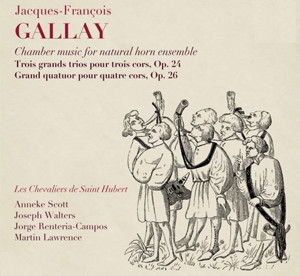
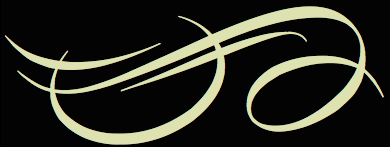 DOWNLOAD FREE DOWNLOAD FREE
ALBUM BOOKLET HERE.
 TRACK LISTINGS TRACK LISTINGS
Grand quatuor pour quatre cors en différens tons, Op. 26
(dedicated to Giovanni Rossini)
I. Allegro con brio
II. Andante con moto
III. Scherzo. Presto
IV. Finale. Vivace
Trois grands trios pour trois cors en Mi, Op.24 No.1
V.
Allegro Marzale
VI. Andante Con Moto
VII. Menuetto
VIII. Allegro Vivo
Trois grands trios pour trois cors en Mi, Op.24 No.2
IX.
Allegro Maestoso
X. Adagio Non Troppo
XI. Menuetto
XII.Allegro Agitato
Trois grands trios pour trois cors en Mi, Op.24 No.3
XII.
Allegro Moderato
XIII. Andante Grazioso
XIV. Menuetto
XV. Finale,Vivace Con Brio
 Recorded at the Musée National de Port Royale des Champs Recorded at the Musée National de Port Royale des Champs
Producer Claude Maury
Engineers Hannelore Guittet/Thibaut
 Instruments: AS Marcel-Auguste Raoux cor d'orchestre (Op. 26), Marcel-Auguste Raoux cor solo (Op.24), JW 1812 Raoux cor d' orchestre (Op.24 and Op. 26), JRC Jungwirth Lausmann copy (Op.26), Marcel-Auguste Raoux cor d'orchestre (Op.24), ML Jungwirth Lausmann copy (Op.26). Instruments: AS Marcel-Auguste Raoux cor d'orchestre (Op. 26), Marcel-Auguste Raoux cor solo (Op.24), JW 1812 Raoux cor d' orchestre (Op.24 and Op. 26), JRC Jungwirth Lausmann copy (Op.26), Marcel-Auguste Raoux cor d'orchestre (Op.24), ML Jungwirth Lausmann copy (Op.26).
 CD REVIEW CD REVIEW
Jacques-François Gallay:
Chamber music for natural horn ensemble
Les Chevaliers de Saint Hubert (Resonus)
Shove a funnel in one end of a length of hose pipe, and explore the quirks and thrills of the natural horn. Namely that most of the low notes are missing or out of tune. The higher harmonics are closer together, making accurate pitching a bit like throwing a dart whilst wearing a blindfold. Getting round the instrument's limitations requires much jiggery-pokery of right hand and lip. A side-effect of the period performance boom is that modern brass and winds can end up seeming just a little dull, a little safe. This unassuming little disc of trios and quartets by Jacques-François Gallay is a triumph – largely because Anneke Scott's Chevaliers de Saint Hubert revel in the eccentricities of their instruments. Stopped notes sizzle and rasp; pedal notes blast out. Faster, chromatic stretches are tossed off with indecent ease. Gallay was a famous cor solo in Paris in the early 19th century, one of the handful of players who pushed hand-horn technique to its limits – before valves came along and things got a bit easier. None of the trios and quartets here are profound music, but each is brilliantly crafted, suggesting that their composer was a grounded, rounded individual with a healthy sense of humour.
The second Trio is the best of the three assembled here; fiery, minor key music. The other two are sparkling amuse-bouches: sample the first Trio's finale if you're unsure. Having three instruments of the same length doesn't allow for much harmonic adventure, and Gallay solved the problem by composing in 1832 his Grand Quartet for four horns in different crooks. The technical complexities don't bear thinking about. At times it's like listening to an operatic ensemble. There's drama, beauty and bite, all delivered with smiling panache. Nicely recorded, and Scott's erudite notes make interesting reading.
Graham Rickson
The Arts Desk
20th of September, 2014.
 CD REVIEW CD REVIEW
Chamber Music for Natural Horn Ensemble.
Les Chevaliers de Saint Hubert.
Anneke Scott, Joseph Walters, Jorge Renteria-Campos,
Martin Lawrence, natural horns.
Resonus Classics ASCD02.
Jacques-François Gallay: Trois grands trios pour trois cors en Mi, Op. 24; Grand Quatour pour quatre cors en différents tons, Op. 26.
Les Chevaliers de Saint Hubert, formed in 2011, comprise four of the leading period horn players in Europe today. The four frequently work together in early music ensembles and specialize in performing on historical horns. On this recording, early 19th-century horns built by Lucien-Joseph Raoux and his son Marcel-Auguste Raoux are joined by copies of Lausmann horns (c. 1790) built by Andreas Jungwirth.
Gallay, the hornist, composer, and pedagogue, is central to the development of the instrument through the 19th century. At the time, soloists on wind instruments in Paris had to compose much of their own repertoire. Gallay was a prolific composer, writing over sixty works from the solo caprices and preludes to large works for horn and orchestra. This collection embodies some of Gallay's finest works for horn, performed here on instruments of the era and in a historically informed style.
The playing on this recording is spectacular! These musicians are masters of their craft - they make the natural horn sound easy. Their intonation and accuracy is spot on, and their phrasing and interpretations are stirring. Anyone interested in natural horn and historical horn performance should buy this CD. Given the importance of Gallay's contribution to the horn's development and pedagogy, every horn player should listen to this recording. Congratulations to Les Chevaliers de Saint Hubert on an excellent and thrilling CD!
Lydia Van Dreel
The Horn Call,
Vol LXIV No. 3 (May, 2014),
International Horn Society.
 CD REVIEW CD REVIEW
Jacques-François Gallay
Chamber Music for Natural Horn Ensemble
Les Chevaliers de Saint Hubert
Anneke Scott, Joseph Walters, Jorge Renteria-Campos and Martin Lawrence - natural horns
Trois grands trios pour trois cors, Op. 24:
Grand Quatuor pour quatre cors, Op. 26.
Anneke Scott has already produced a solo CD of Gallay’s Preludes, Caprices & Fantaisies (Resonus RES10114) which was the outcome of her research in Paris, funded by a Finzi Scholarship in 2010. The present disc is an extension of that work and presents some of Gallay’s chamber music for horns alone. She is joined by Joe Walters and Jorge Renteria-Campos for the trios and Martin Lawrence added for the Grand Quartet.
The new CD has the same hallmarks as her previous CD - meticulous scholarship and musical intelligence. When this is combined with the panache and virtuosity of the players, this CD makes a compelling presentation of these pieces. The recordings were made in Paris and produced by one of Anneke’s teachers, Claude Maury. The trios are all played on Raoux horns of the period, and the quartet on two Raoux and two Jungwirth copies of hand horns made by Lausmann around 1790.
When one compares the Gallay trios with those of Reicha - works with which most horn players are familiar - the Gallay trios Op. 24 are conceived on a much grander scale and explore a greater range of musical feeling. Each trio is a four movement work with a quasi-symphonic structure - having an opening Allegro, a slow movement, a minuet or scherzo and a flamboyant finale. They are certainly dramatic works and, as one would expect from music by a virtuoso player, they push hand horn technique to the limits. They are played here with great energy in the quick movements, counterbalanced by some wonderfully reflective playing in the slow movements.
The jewel on this disc, however is the Grand Quatuor Op. 46. As Anneke points out in the CD booklet, solo wind players in the 19th century were often composers by default - since instruments and playing techniques were developing so raptly that performers were often the people best placed to exploit this musical potential. Jacques-François Gallay was certainly a most talented composer in these terms, and it was his genius to recognise that, were he to write for a horn quartet with each of the horns crooked in different keys, this might open up yet another new range of artistic possibilities. Many composers before him had used pairs of horns crooked in different keys. However, in this quartet Gallay writes for the first horn on the G crook, the second in E, the third in both D and E, and the fourth in C basso. This gave him new harmonic and melodic possibilities and also allowed him to fully exploit the varying timbral colours of differently pitched crooks. He makes full use of all these possibilities in this work, yet always as the servant of the musical argument. The Grand Quatuor is a seminal work in the development of horn ensemble music, and is, in my view, Gallay’s masterpiece.
The opening theme of the work is memorable and assertive; the slow movement has elegance and poise; there is a Scherzo Presto of which Mendelssohn would have been proud; and the last movement has genuine humour. It is a work that lasts over 20 minutes but it flies past and is over all too soon. The performance here is quite astonishing musically and technically. The best recommendation that I can give came from a horn playing friend who is not deeply into original instrument performance. He listened carefully and said “Well that’s a performance where one doesn’t need to make any allowance for it being on original instruments”.
Paul Sawbridge.
The Horn Player.
Volume 11, Number 1, 2014.
British Horn Society.
 CD REVIEW CD REVIEW
Les Chevaliers de Saint Hubert.
Jacques-François Gallay:
Chamber Music for Natural Horn Ensemble,
Resonus (ASCD02), 2013.
Personnel: Anneke Scott, Joseph Walters, Jorge Renteria-Campos, and Martin Lawrence, horns
The music on this recording includes Gallay’s Grand Trios for Horns, Op. 24 and Grand Quartets, Op. 26. The playing is fantastic and an added bonus is that the performers use horns from the period of Gallay’s lifetime. These include horns built by Lucien-Joseph Raoux in 1812 and Marcel-Auguste Raoux in the 1820s, with the only exceptions being two horns by Andreas Jungwirth that are copies of a Lausmann horn built c. 1790. The acoustics of the hall in which the recording was made (Musée national de Port Royale des Champs, France) allow the subtleties of ensemble playing to come through nicely. These include details such as breathing and the slightly different tone qualities of each player. The intonation throughout is spot on, and the quick passages display true virtuosity from all players, and the wonderful colors created by the different open and stopped tones come through with amazing clarity
Eric Brummitt,
Historic Brass Society, August 2014.
 CD REVIEW CD REVIEW
GALLAY - HORN DUOS AND TRIOS - SHEER DELIGHT!
When you think of a horn trio, you would inevitably think of a work which involved a French horn with two other instruments. But on this new recording from Les Chevaliers de Saint Hubert (Anneke Scott, Joseph Walters, Jorge Renteria-Campos, Martin Lawrence) we are treated to a group of works for three and four horns by the 19th century French composer (and horn virtuoso) Jacques-Francois Gallay. His Trois grands trios pour trois cors en Mi, Op.24 and Grand quatuor pour quatre cors en different tons, Op. 26. The recordings is on the Resonus Classics label, for download only.
Horn ensembles probably arose from the hunt servants being called upon to provide entertainment for the hunters. Certainly by the late 17th and 18th centuries such ensembles were being written down. The Bohemian composer Anton Reicha (1770 - 1836) wrote 24 horn trios (op.82) and 12 trios for two horns plus cello or bassoon (Op. 93). In 1811 the distinguished French horn player Louis-Francois Dauprat (1781-1868) decided to improve his composition skills and spent three years studying with Reicha. The two went on to become colleagues at the Paris Conservatoire. Jacques-Francois Gallay was the most distinguished of Dauprat's pupils. He was born in Perpignan in 1795, learning the horn from his amateur horn player father. Something of a prodigy, Gallay eventually decided to study at the Paris Conservatoire where the calibre of its hand-horn players was such that the new valve horn remained unpopular in France. On graduation Gallay become one of the leading performers of the time.
Gallay was a prolific composer writing a lot of works for solo horn, plus two of the most challenging works for horn ensemble, those recorded here. Trois grands trios pour trois cors en Mi, Op. 24 were written in around 1830, each trio is a three-movement work consisting of an opening allegro, slow movements, minuet or scherzo and trio, then a virtuosic finale.
The first trio opens with a lively Allegro Marziale, in which we are introduced to the lovely colours of a work for three hand-horns. On these horns, chromatic notes are created by hand stopping, so that each note is a slightly different colour. The style of the music is very much reminiscent of Weber. Next comes a gentle, lyrical Andante con moto with the horns creating a fascinating texture. The minuet is a wonderfully lively, jig-like piece, great fun with a lyrical trio. The finale is rather lively with a sort of hunting-tune feel to it.
The Allegro maestoso of the second trio opens with a grand gesture before developing as a rather Mozartian Allegro albeit with some dramatic moments all played with lively energy. The Adagio is gentle and lyrical with a lovely sense of movement in the parts. This is followed by an imaginative scherzo with a flowing trio. The finale is melodious again with a rather Mozartian cast to the first subject.
The third trio starts lyrically gentle before developing into something livelier. The graceful Andante has something of a march about it, with the minuet being rather misterioso with more than a nod to Weber. Finally a jolly hunting-call finale with some nifty twiddly bits.
Whereas the trios had all four horns in the same key, for the quartets Gallay uses four horns each in a different key. During the 19th century it was common for orchestras to use horns in pairs, having two each in different keys. Here Gallay has four different. Using the four different keys on the horns increases the harmonic range of the composition and this is a far more developed and complex work. The quartet is dedicated to Rossini (who himself wrote a work for four horns). It was premiered at a soiree in 1833 held at the house of the piano maker, Dietz. Gallay and his former teacher Dauprat were amongst the players.
The quartet's opening Allegro is a lively piece, but quite complex musically, and we are treated to a whole array of hand stopping making a lovely textures. The Andante is a gentle, minor key piece which is rather evocative with some subtle textures. The scherzo is a rather jolly hunting gallop with a lyrical middle section. The work concludes with a spirited finale.
The ensemble, Les Chevaliers de Saint Hubert was formed specifically to record the Gally quartet and comprises four of London's finest period horn players, Anneke Scott, Joseph Walters, Jorge Renteria-Campos and Martin Lawrence. They are playing on horns all made by the Parisian firm of Raoux, including one by Marcel-Antoine Raoux from the Bate Collection. Gallay's own horn (still preserved in Paris) was made by a member of the Raoux family.
I have to confess that I was not certain what to expect when I first listened to this disc. I was familiar with the world of the hand-stopped horn from Anneke Scott's recording of instruments from the Bate collection (see my review), but an ensemble of horns. In fact, I was charmed and delighted. The textures and sounds arising from the combinations of different hand-stoppings and open notes, results in an entirely new sound world.
The playing from all four horn players is superb, each showing amazing control and producing some amazing bravura moments. These are not the greatest of works of art, you can sense in them moments when Gallay is wondering what will show off the horns best rather than what will work musically. But they represent an important genre and deserve a hearing. In these performances, they do more than that and I shall certainly be listening to this entrancing disc again.
Robert Hugill
Planet Hugill - A world of classical music.
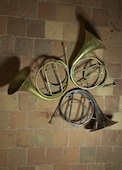 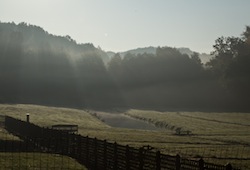 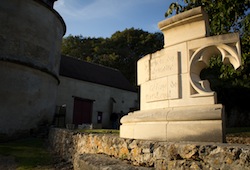 
|